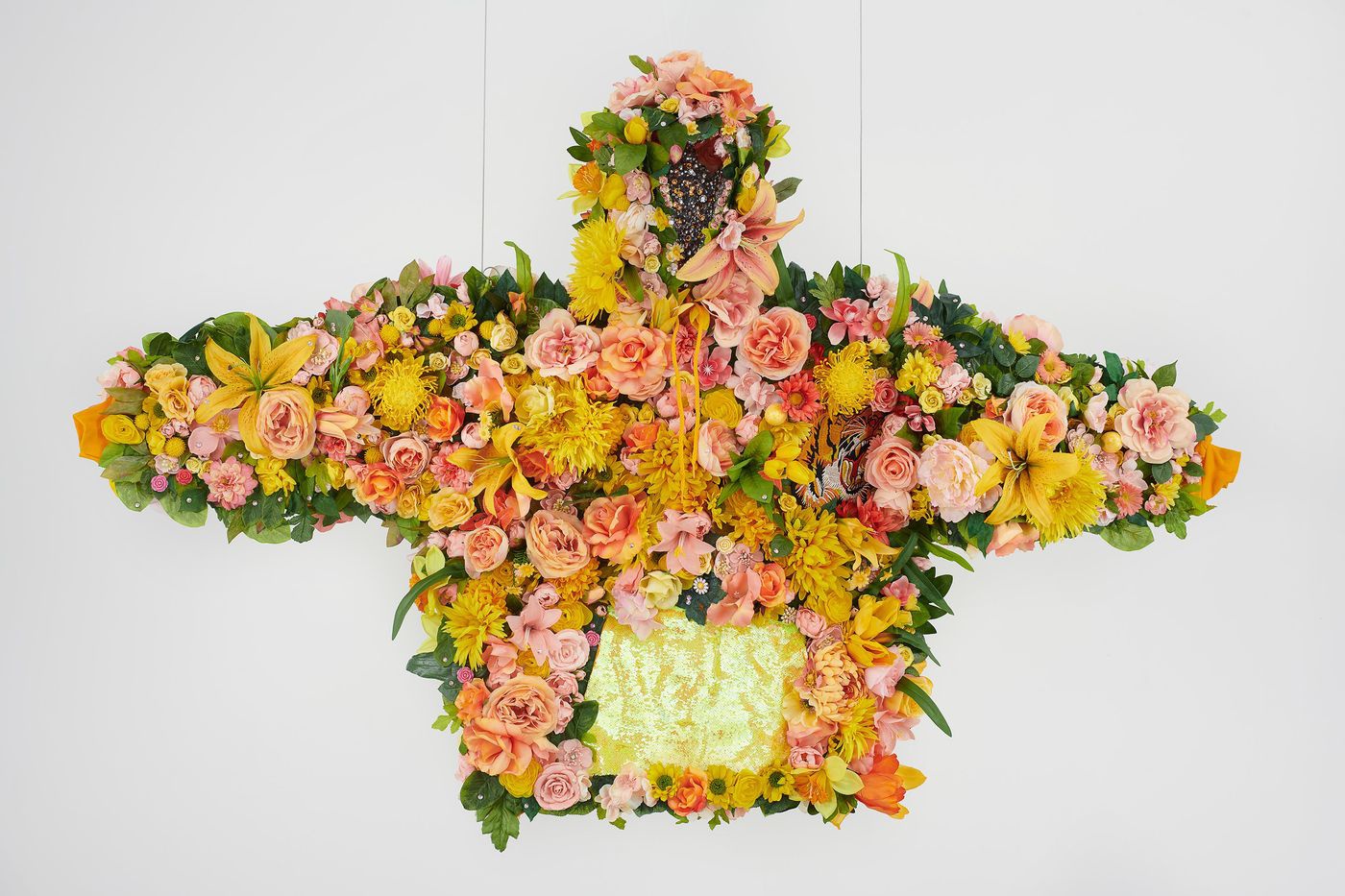
In an exhibition at the Museum of Arts and Design, a parade of fashion-adjacent creations in which artists elevate clothing into a different realm.
The word “garment” comes from the old French word “guarnement,” a single piece of clothing, which derives from the older French “garnir”—to arm, to armor, to protect. Jump to 20th-century Manhattan and the term “garmento” pops up, slang for someone who works in the garment industry in the Garment District, the 30s west of Fifth Avenue. There’s a Damon Runyon whiff of the mob about the word (those midcentury manufacturers were tough), so it’s no longer politically correct to say. Doesn’t matter anyway, because the West 30s have gentrified and the word garment has evolved into something meta, “garmenting,” which sounds like a home-sewing version of scrapbooking and does in fact draw on memories and emotions.
“Garmenting: Costume as Contemporary Art” is an exhibition at the Museum of Arts and Design that introduces viewers to a rich recent form of artistic expression, one that has gained a foothold in galleries and museums in the new millennium. While it isn’t fashion, garmenting is body-based and employs fashion’s vocabulary of silhouettes, structural echoes and embellishment. In the exhibition catalog, the show’s curator, Alexandra Schwartz, an art historian who is also an adjunct professor at SUNY Fashion Institute of Technology, defines the word with supreme clarity, writing that it “refers to clothing made or altered by artists and exhibited as sculpture or installation; sometimes, this clothing doubles as costume for live or video-based performance art.” One could also say that it expands on the old French “garnir” with some new infinitives: to question, to protest, to transcend.
The exhibition fills two floors of MAD, the fourth and fifth, with the works of 35 artists organized around five categories: “Functionality,” “Cultural Difference,” “Gender,” “Activism” and a video section called “Performance.” It’s best to begin on the fifth floor, which contains a brief photographic history of garmenting, and where “Functionality” makes sense as a starting point.
Citing the traditional hierarchical divide between the fine and applied arts, Ms. Schwartz writes that “Garmenting offers a critique of this division by questioning what makes a garment ‘functional’ (i.e., wearable in everyday life) versus ‘art’ (i.e., for exhibition or performance).” There’s a lot of wiggle room in that sentence, but all is simplified by the first piece in this section, “Untitled” (2000), a miniskirt made by the Brazilian artist Nazareth Pacheco. This latticework of glass pearls is beautiful and seemingly wearable—it recalls the diamanté headdress on Diana Vreeland’s Vogue cover of December 1965—until you notice that the hem is fringed with the blades of scalpels. Contemplating the zone between knees and waist, Ms. Pacheco creates a glittering cage that holds both pleasure and pain, the complexity of sex.
Some pieces are more statement than art, like Beverly Semmes’s “Famous Twins” (1993), two simply constructed dresses of velvet and cotton that are scaled ceiling to floor, equating female empowerment with a marshaling of space. But then there’s Vivan Sundaram’s “Hair” (2011), a sort of Victorian mourning mantle made of braided hair, black and brown, worked into a surface that looks like Persian lamb. It’s an abstract memento mori. The sculpture by Louise Bourgeois, “Blue Days” (1996), placed in the middle of the gallery, is lighter and airier. On a circular metal structure that’s not unlike a laundry rack or a tree, the artist hung seven vintage pieces from her own wardrobe, all blue. One of the metal limbs holds a red glass ball—mankind’s fall, mother’s blood.

Devan Shimoyama, February II, 2019. Photo by Phoebe Dheurle.
“Cultural Difference” is about identity and frequently reaches back to the root word “garnir,” to armor. This art is not just about protection of an individual but of cultures. Three works by Nick Cave are a mini Mardi Gras of color—camouflage that conceals everything about the wearer while pinpointing a threat: “Soundsuit” (2018) has a towering face-covering hood that is Klan-like; “Hustle Coat” (2017) lines a detective’s trench with the gold knockoffs of street vendors. Perhaps more poetic is Xenobia Bailey’s “Zulu Queen Harvest Fire Coat” (1990), which crochets the aesthetics of Namibia, the Zulu people and 19th-century Britain into a black dress with bright accents.
On the fourth floor, “Gender” and “Activism” flow one into the other. Zoë Buckman’s “Every Curve” (2016) is a collection of women’s undergarments—slips, camisoles, corsets—suspended hauntingly from the ceiling, each piece embroidered with a rap lyric, mostly misogynist. It isn’t pretty, this drift of revenants. Oliver Herring’s “Hanging Coat Nr 1” (1993) was made to honor the queer performance artist Ethyl Eichelberger, who died by suicide in 1990, two years after he was diagnosed with AIDS. Knitted from transparent tape and reflective Mylar, materials that yellow with time, the coat looks like a golden fleece—the mythical symbol of kings.
With works by Karina Bisch, Sanford Biggers, Raúl de Nieves, Jacolby Satterwhite and Jeffrey Gibson in the show, “Garmenting” brings us up to speed on names we should know. Devan Shimoyama, at age 33 one of the youngest artists here, created the sculpture that graces the exhibition catalog. Floating high on a wall, it’s a hoodie with arms outspread so that it resembles a crucifix. Completely covered with silk roses, lilies and daisies in yellows, peaches and pinks, it’s like the pelt of flowers on a coffin. The hood is empty except for a tumble of rhinestones glinting within. Titled “February II” (2019), it is Mr. Shimoyama’s tribute to Trayvon Martin —risen.




